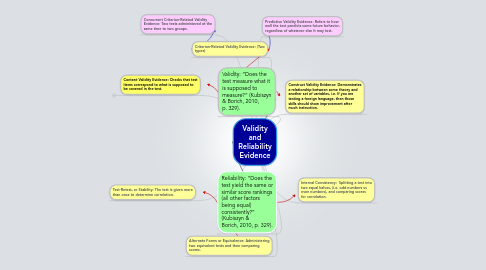Validity and Reliability Evidence
by DOLORES AUSTIN

1. Alternate Forms or Equivalence: Administering two equivalent tests and then comparing scores.
2. Test-Retest, or Stability: The test is given more than once to determine correlation.
3. Concurrent Criterion-Related Validity Evidence: Two tests administered at the same time to two groups.
4. Criterion-Related Validity Evidence: (Two types)
5. Content Validity Evidence: Checks that test items correspond to what is supposed to be covered in the test.
5.1. New node
6. Reliability: “Does the test yield the same or similar score rankings (all other factors being equal) consistently?” (Kubiszyn & Borich, 2010, p. 329).
7. Validity: “Does the test measure what it is supposed to measure?” (Kubiszyn & Borich, 2010, p. 329).
8. Internal Consistency: Splitting a test into two equal halves, (i.e. odd numbers vs even numbers), and comparing scores for correlation.
9. Construct Validity Evidence: Demonstrates a relationship between some theory and another set of variables, i.e. If you are testing a foreign language, then those skills should show improvement after much instruction.
10. Predictive Validity Evidence: Refers to how well the test predicts some future behavior, regardless of whatever else it may test.


